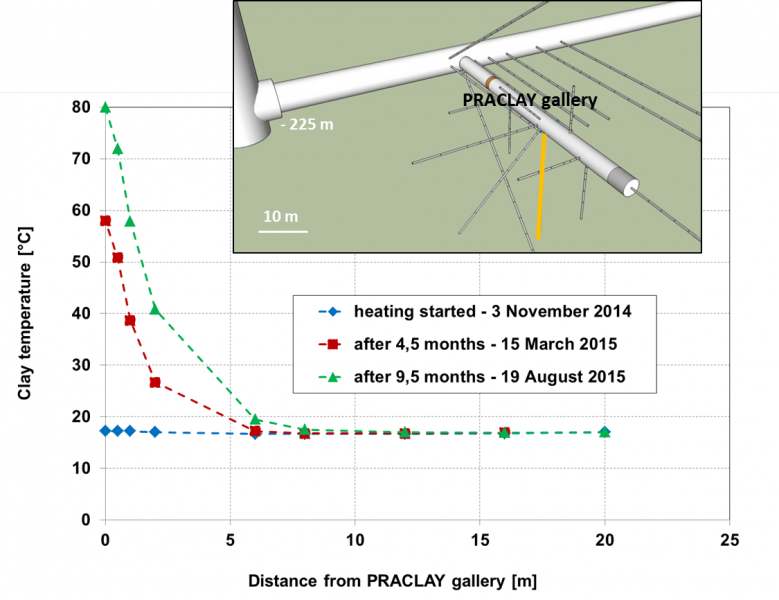Underground heater experiment now up and running

The start-up phase of the large-scale PRACLAY Heater experiment in the HADES underground research laboratory in Mol has been successfully completed. On 19 August, the temperature around the gallery reached the targeted 80°C, marking the formal beginning of the 10-year heating phase of the experiment, during which the temperature will be kept constant. The experiment is a key milestone in the research programme coordinated by the Belgian Agency for Radioactive Waste and Enriched Fissile Materials (ONDRAF/NIRAS) to investigate geological disposal of radioactive waste in a clay host rock. The HADES underground research laboratory, where the experiment is being conducted, has been built in the Boom Clay formation, at a depth of 225 metres under the site of SCK CEN in Mol.
Why is this experiment actually being carried out?
Impact of heat
High-level radioactive waste gives off heat. So if an underground disposal solution is adopted, the clay surrounding the waste will also be heated up. Small-scale heater experiments have already shown that clay retains its ability to physically contain radioactive substances when it is heated. Scientists are now seeking to confirm and refine existing knowledge about the behaviour and properties of clay when it is subjected to heat on a scale that is representative of a real disposal facility. The PRACLAY experiment also provides an opportunity to study how the rise in temperature affects the stability of the concrete gallery lining in conditions that are similar to those that will be encountered in a repository for radioactive waste. This knowledge is important if the option of retrieving the waste is to be considered. Last but not least, the experiment offers a unique chance to test the reliability of the measuring instruments used, at elevated temperature and over a long period of time.
Watch this short film to find out more about the preparation, evolution and objectives of the experiment.
Start-up phase successfully completed
On 3 November 2014 researchers began heating up the PRACLAY gallery. Over a period of a little more than nine months, the power of the heating system was systematically ramped up until the target temperature of 80°C was reached at the point where the gallery lining meets the clay. This corresponds to the temperature that would be expected in a real high-level waste repository. Temperature sensors placed in the boreholes drilled around the gallery monitor the clay as it heats up. Besides temperature, sensors also constantly measure the pressure, permeability and chemical characteristics of the clay.
The graph below shows the temperature profiles at three different points in time, measured in a vertical borehole (yellow line in the drawing) that descends from the centre of the heated section of the gallery. The temperatures measured confirm the existing knowledge.

| Figure - The dotted lines show clay temperature as a function of distance from the gallery, measured in a 20-metre vertical borehole (indicated as a yellow line in the drawing). Initially, the clay temperature was below 20°C (blue curve). Some 4½ months after the heating system was switched on (red curve), the temperature at the point of contact between the gallery lining and the clay was approximately 58°C (red curve); the clay located 10 metres beyond the lining had not yet heated up. On 19 August, as can be seen in the graph, the temperature reached 80°C at this gallery/clay interface (green curve). The clay is only heated up to a distance of about 10 metres. |
Click here to learn more about the experiment. You can find full technical details about the design and installation of the PRACLAY experiment in the report entitled ‘The Design and Installation of the PRACLAY In-Situ Experiment’.
